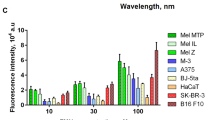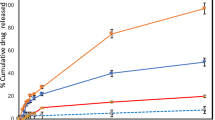Abstract
Cancer therapy using minimal invasive technique has been a challenge since decades. In the present research, the concept of photodynamic cancer therapy (PDT) has been applied on biologically synthesized nanoparticles for the treatment of skin melanoma (B16F10) and epidermoid carcinoma (A431) cells. The biologically synthesized nanoparticles have been conjugated with a photosensitizer drug 5-aminolevulinic (5-ALA) acid to treat cancer cells by activating the protoporphyrin IX (PpIX) formation through irradiation. Bacterial strain Escherichia coli was used for the synthesis of gold nanoparticles. The size and characteristics of nanoparticles were studied with scanning electron microscope, dynamic light scattering and zeta potential analysis. The gold nanoparticles were encapsulated with polyethylene glycol (PEG) and tagged with 5-aminolevulinic acid, a photosensitizer drug. The drug was activated using a halogen lamp to enhance the production of reactive oxygen species (ROS) molecules. The cytotoxicity of pure nanoparticles and conjugated nanoparticles were assessed on skin melanoma and epidermoid carcinoma cell lines and compared against standard drug 5-ALA, and the production of ROS molecules was measured using a 2,7 dichlorofluorescein-diacetate (DCFH-DA) probe. The results indicated that pure gold nanoparticles had greater cytotoxicity on cells compared to 5-ALA and gold-5-ALA conjugate. But when the cells were subjected to irradiation, the gold-5-ALA conjugate showed higher cytotoxicity than 5-ALA and pure nanoparticles. The cytotoxic levels of gold-5-ALA conjugates were doubled which indicated greater reactive oxygen molecule production compared to other samples.












Similar content being viewed by others
References
Samali A, Gorman AM, Cotter TG (1996) Apoptosis the story so far. Experentia 52:933–941
Slater AF, Stefan C, Nobel I, van den Dobbelsteen DJ, Orrenius S (1995) Signalling mechanism and oxidative stress in apoptosis. Toxicol Lett 82-83:149–153
Aruna U, Raja Lakshmi R, Muzib I, Vinesha V, Sushma M, Vandana KR, Vijay Kumar N (2013) Role of chitosan nanoparticles in cancer therapy. Int J Innov Pharm Res 4(3):318–324
Hooper C (2000) Photodynamic therapy: a clinical reality in the treatment of cancer. Lancet Oncol 1:212–219
Shi L, Wang X, Zhao F, Luan H, Tu Q, Huang Z, Wang H, Wang H (2013) In vitro evaluation of 5-aminolevulinic acid (5-ALA) loaded PLGA nanoparticles. Int J Nanomed 8:2669–2676
Xu H, Liu C, Mei J, Yao C, Wang S, Wang J, Li Z, Zhang Z (2012) Effects of light irradiation upon photodynamic therapy based on 5-aminolevulinic acid-gold nanoparticles conjugates in K562 cells via singlet oxygen generation. Int J Nanomed 7:5029–5038
Huang L, Rudolph M, Rominger F, Hashmi AS (2017) Photosensitizer-free visible-light-mediated gold-catalyzed 1,2-difunctionalization of alkynes. Angew Chem 55(15):4808–4813
Huang L, Rudolph M, Rominger F, Hashmi AS (2016) A general access to organo gold(III) complexes by oxidative addition of diazonium salts. Chem Commun 52:6435–6438
Witzel S, Xie J, Rudolph M, Hashmi KS (2016) Photosensitizer-free, gold-catalyzed C–C cross-coupling of boronic acids and diazonium salts enabled by visible light. Adv Synth Catal 359(9):1522–1528
Xie J, Li J, Weingand V, Rudolph M, Hashmi KS (2016) Intermolecular photocatalyzed heck-like coupling of unactivated alkyl bromides by a dinuclear gold complex. Chem Eur J 22(36):12646–12650
Xie J, Zhang T, Chen F, Mehrkens N, Rominger F, Rudolph M, Hashmi KS (2016) Gold-catalyzed highly selective photoredox C(sp(2) )-H difluoroalkylation and perfluoroalkylation of hydrazones. Angew Chem 55(8):2934–2938
Xie J, Shi S, Zhang T, Mehrkens N, Rominger F, Rudolph M, Hashmi KS A highly efficient gold-catalyzed photoredox α-C(sp3)H alkynylation of tertiary aliphatic amines with sunlight. Angew Chem 54(20):6046–6050
Oo MKK, Yang X, Hu H, Wang H (2008) 5-Aminolevulinic acid conjugated gold nanoparticles for photodynamic therapy of cancer. Nanomedicine 3(6):777–786
Sriram MI, Kalishwaralal K and Gurunathan S (2012) Methods and protocols, Methods in Molecular Biology, Nanoparticles in Biology and Medicine. 906:33–43
Crouch SPM, Kozlowski R, Slater KJ, Fletcher J (1993) The use of ATP bioluminescence as a measure of cell proliferation and cytotoxicity. J Immunol Methods 160(1):81–88
El-Raheem Abd, El-Shanshoury, Elsilk SE, Ebeid ME (2012) Rapid biosynthesis of cadmium sulphide nanoparticles using culture supernatants of Escherichia coli ATCC8739, Bacillus subtilis ATCC 6633 and Lactobacillus acidophilus DSMZ 20079T. Afr J Biotechnol 11(31):7957–7965
Mandal D, Bolander ME, Mukhopadhyay D, Sarkar G, Mukherjee P (2006) The use of microorganisms for the formation of metal nanoparticles and their application. Appl Microbial Biotechnol 69(5):485–492
Aishwarya S, Sanjay KR (2015) Study on biological synthesis of cadmium sulfide nanoparticles by Bacillus licheniformis and its anti bacterial properties against food borne pathogens. Nanosci Nanotechnol Res 3(1):6–15
Morgan DML (1998) Polyamine protocols in tetrazolium (MTT) assay for cellular viability and activity, Polyamine protocols 79:79–184.
Gongalez RJ, Tarloff JB (2001) Evaluation of hepatic sub cellular fractions for alamar blue and MTT reductase activity. Toxicol In Vitro 15(3):257–259
Denizot F, Lang R (1986) Rapid colorimetric assay for cell growth and survival, modifications to the tetrazolium dye procedure giving improved sensitivity and reliability. J Immunol Methods 89(2):271–277
Mohammadi Z, Sazgarnia A, Rajabi O, Soudmand S, Esmaily H, Sadeghi HR (2013) An in vitro study on the photosensitivity of 5-aminolevulinic acid conjugated gold nanoparticles. Photodiagnosis Photodyn Ther 10:382–388
Liu Y, Shipton MK, Ryan J, Kaufman ED, Franzen S, Feldheim DL (2007) Synthesis, stability and cellular internalization of gold nanoparticles mixed peptide polyethylene glycol monolayers. Anal Chem 79:2221–2229
Miah MI Fluorescence spectroscopy study of protoporphyrin IX metabolism level in cells. Biopolym Biospectrosc 62(5):237–240
Bilski P, Belanger AG, Chignell CF (2002) Photosensitized oxidation of 2, 7 dichlorofluorescin: singlet oxygen does not contribute to the formation of fluorescent oxidation product 2, 7 dichlorofluorescein. Free Radic Biol Med 33:938–946
Acknowledgments
The authors are grateful to Sri Jayachamarajendra College of Engineering, Mysuru for providing all facilities to carry out this work. We thank the Institute of Excellence (IOE), University of Mysore for providing advanced instrumentation facility at their institute.
Funding
The authors are thankful to Technical Education Quality Improvement Program (TEQIP), Government of India for providing financial assistance for the work.
Author information
Authors and Affiliations
Corresponding author
Ethics declarations
Conflict of interest
The authors declare that there is no conflict of interest.
Rights and permissions
About this article
Cite this article
Aishwarya, S., Sanjay, K.R. Conjugation study of 5-aminolevulinic acid with microbial synthesized gold nanoparticles to evaluate its effect on skin melanoma and epidermoid carcinoma cell lines using photodynamic cancer therapy. Gold Bull 51, 11–19 (2018). https://doi.org/10.1007/s13404-017-0224-x
Received:
Accepted:
Published:
Issue Date:
DOI: https://doi.org/10.1007/s13404-017-0224-x




